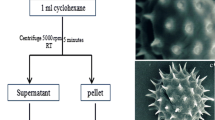Summary
The stigmas of the heterostylous genusPrimula are of the “dry” type without a free-flowing surface secretion. The papillae of the stigma surface cells of the two morphs, in pin (stigma exserted) and thrum (stamens exserted), bear a thin proteinaceous surface pellicle, overlying a discontinuous cuticle. The vacuoles of the papillate cells contain tannins, and tannin cells extend in files through the stigma heads and form a loose sheath surrounding the pollen-tube transmitting tract in the styles. The cells of the transmitting tissue in the stigma heads have a normal complement of organelles, and abundant ribosomal endoplasmic reticulum. The intercellular spaces contain an internal secretion which reacts cytochemically for both carbohydrate and protein. The transmitting tract in the styles forms a central core surrounded by several vascular strands. The cells are elongated, and the intercellular spaces here also have a carbohydrate-protein content. In a compatible pollination, thrum pollen tubes enter the stigma by penetrating the cuticle at the tip or on the flank of the pin papilla. Pin tubes on the thrum stigma enter between adjacent papillae, penetrating the thin cuticle at the base. The tubes grow through the transmitting tracts in the intercellular material.
Similar content being viewed by others
References
Bell, J., Hicks, G., 1976: Transmitting tissue in the pistil of tobacco. Light and electron microscope observations. Planta (Berl.)131, 187–200.
Boyer, M. G., 1963: The role of tannins in neutral red staining of pine leaf vacuoles. Stain Technol.38, 117–120.
Christ, B., 1959: Entwicklungsgeschichtliche und physiologische Untersuchungen über die Selbsterilität vonCardamine pratensis L. Z. Bot.47, 88–112.
Cresti, M., van Went, J. L., Pacini, E., Willemse, M. M. M., 1976: Ultrastructure of transmitting tissue ofLycopersicum peruvianum style: development and histochemistry. Planta (Berl.)132, 305–312.
Darwin, C., 1862: On the two forms, or dimorphic condition, in the species ofPrimula, and on their remarkable sexual relations. Proc. Linn. Soc. (Botany)6, 105–139.
Dumas, C., 1975: Le stigmate et la sécrétion stigmatique. Thèse présentée devant l'Université Claude-Bernard, Lyon, pp. 1–256.
Eschrich, W., Currier, H. B., 1964: Identification of callose by its diachrome and fluorochrome reactions. Stain Technol.39, 303–307.
Feder, N., O'Brien, T. P., 1968: Plant microtechnique: some principles and new methods. Amer. J. Bot.55, 123–142.
Ganders, F. R., 1979: The biology of heterostyly. New Zeal. J. Bot.17, 607–636.
Gardner, R. O., 1975: Vanillin-HCL as a histochemical test for tannin. Stain Technol.50, 315–317.
Golynskaya, E. L., Bashrikova, N. V., Tomchuk, N. N., 1976: Phytohaemagglutinins of the pistil inPrimula as possible proteins of generative incompatibility. Sov. Plant. Physiol.23, 169–176. (Translated from Fiziologiya Rasteni23, 88–97.)
Gurr, E., 1965: The rational use of dyes in biology. London: Leonard Hill.
Heslop-Harrison, J., 1976: A new look at pollination. Rep. East Malling Res. Stn. for 1975, 141–157.
—, 1979: Aspects of the structure, cytochemistry and germination of the pollen of rye (Secale cereale L.). Ann. Bot.44 (Suppl.), 1–47.
—,Heslop-Harrison, Y., 1979: Ann. Rep. Welsh Plant Breed. Stn.1978, 150–151.
— —, 1980: The pollen-stigma interaction in the grasses. I. Fine-structure and cytochemistry of the stigmas ofHordeum andSecale. Acta Bot. Neerl.29, 261–276.
- - 1981: The specialised cuticles of stigma papillae. In: The plant cuticle (Cutler, D. F., ed.). J. Linn. Soc. Suppl. (in press).
— —,Barber, J., 1975: The stigma surface in incompatibility responses. Proc. Roy. Soc. Lond. B188, 287–297.
Heslop-Harrison, Y., 1977: The pollen-stigma interaction: pollen tube penetration inCrocus. Ann. Bot.41, 913–922.
—,Heslop-Harrison, J., 1981: The digestive glands ofPingulcula: fine-structure and cytochemistry. Ann. Bot.47, 293–319.
—,Shivanna, K. R., 1977: The receptive surface of the angiosperm stigma. Ann. Bot.41, 1233–1258.
Knox, R. B., Heslop-Harrison, J., 1970: Pollen-wall proteins: localisation and enzymic activity. J. Cell Sci.8, 727–733.
Kroh, M., Helsper, J. P. F. G., 1974: Transmitting tissue and pollen tube growth. In: Fertilisation in higher plants (Linskens, H. F., ed.), pp. 167–175. Amsterdam-New York: North-Holland American Elsevier.
Linskens, H. F., 1975: Incompatibility inPetunia. Proc. Roy. Soc. London B188, 299–311.
Luft, J. H., 1964: Electron microscopy of cell extraneous coats as revealed by ruthenium red staining. J. Cell Biol.23, 55 a.
Maeda, H., Ishida, N., 1976: Specificity of binding of hexapyranosyl polysaccharides with fluorescent brightener. J. Biochem. (Tokyo)62, 276–278.
Mattsson, O., Knox, R. B., Heslop-Harrison, J., Heslop-Harrison, Y., 1973: The protein pellicle of stigmatic papillae as a probable recognition site for incompatibility reactions. Nature (Lond.)147, 298–300.
Nettancourt, D. de, Devreux, M., Bozzini, A., Cresti, M., Pacini, E., Sarfatti, G., 1973: Ultrastructural aspects of self-incompatibility mechanism inLycopersicon peruvianum Mill. J. Cell Sci.12, 403–419.
Ornduff, R., 1979: Pollen flow in a population ofPrimula vulgaris Huds. Bot. J. Linn. Soc.78, 1–10.
Pearse, A. G. E., 1972: Histochemistry: theoretical and applied, Vol. 2. Edinburgh-London: Churchill Livingstone.
Sassen, M. M. A., 1974: The stylar transmitting tissue. Acta Bot. Neerl.23, 99–105.
Author information
Authors and Affiliations
Rights and permissions
About this article
Cite this article
Heslop-Harrison, Y., Heslop-Harrison, J. & Shivanna, K.R. Heterostyly inPrimula. 1. Fine-structural and cytochemical features of the stigma and style inPrimula vulgaris huds. Protoplasma 107, 171–187 (1981). https://doi.org/10.1007/BF01275616
Received:
Accepted:
Issue Date:
DOI: https://doi.org/10.1007/BF01275616




